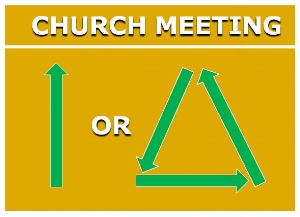Making the Most of Every (Sunday) Opportunity
In the last blog, I asked you to envision your church. Most of us, I suspect, can easily picture the gathered church as a meeting-room full of people. But how might we visualize the church scattered? Does this picture come close?
Not so fast, some might say. In Jesus’s parable, “seed” means the word of God. You know the story. Wanting a harvest, a farmer goes out to plant. The seed lands on soil of varying quality. When his disciples ask him to explain, Jesus says, “The seed is the word of God.” Definition given. Conversation over . . .
. . . Until We Read On
In Matthew’s gospel, right after explaining this parable, Jesus goes on to tell a second. In this next one, seed means something else. As before, the farmer goes out and scatters seed in his field. But then an enemy of the farmer sneaks in after dark and blankets the same ground with weed seed. Jesus’s disciples ask him to explain. The good seed in this case, he says, “stands for the people of the Kingdom” (Matt. 13:38, NLT).
In this parable, seeds are . . . people. And the people-seeds are all spread out. So maybe seed does give us a good visual of the church scattered.
Jesus told his seed parables to explain the Kingdom. The seed image, then, helps us see God’s strategy for Kingdom fruit. He plants seed—not only word-as-seed but also people-as-seed. So those gathered on a Sunday morning are not simply the people of the church. They are the seed-people of God’s much larger kingdom.
Two quick points about the second parable:
One: Jesus scatters his seed-people. His sowing hand has sent them flying into the field of his world—into homes, into workplaces, and into neighborhoods to take root there. To thrive. To produce Kingdom fruit. And, as one writer has put it, to provide “foretastes” of the fully-revealed Kingdom yet to come. They spend vastly more time out there than cloistered in a church building.
Two: Seed-people face stiff resistance. The enemy, the devil, has broadcast weed-seed-people right in among Jesus’s good-seed-people. Growing and producing fruit for God in the scattered church is no picnic. It’s a constant struggle for root-space, branching-out-space, water, and sunlight. So maybe we need to change slightly our picture of the scattered church:
Preparing Seed-People to Scatter
This revised picture of the scattered church raises a most-important question about how to structure our time together in the gathered church. As we saw in the last blog, a 75-minute church meeting gets less than one percent the 100,080 minutes in a week. A tiny fund of time. How can we best use it to get the scattered seed-people ready for the challenges and opportunities they meet out there?
Or ask the same question in different words: How can time in the gathered church equip, build, and encourage Christians for serving God and others in their weekdays? Three words in that question point us to what we see happening in the New Testament church:
Equipping. This is the special task of church leaders (Eph. 4:11, 12). God’s people will spend most of their week in families, neighborhoods, and workplaces. They will be scattered among unbelievers who are walking radically different paths. What truths and tools will the good-seed-people need for serving God and others Monday through Saturday. How will they practice using those tools?
Building. The ministry of body-building—strengthening Christ’s body—belongs to all the Christians: “The body builds itself in love as each part does its work” (Eph. 4:16). Serving God and others in the scattered church takes spiritual muscle. God calls each member of Christ’s body to build others and be built up by them (I Thess. 5:11). This can happen only in the gathered church. You and I can’t use our gifts to build each other up while miles apart all week.
Encouraging. Encouragement too is the responsibility of all the believers, not just church leaders. Serving God and people in dark and difficult places can wear us down and out. (A Christian I know who leads seminars sometimes gets marked down in evaluations for using the gendered pronouns—he, she, etc..) Our counter strategy? We are to “encourage one another” (Heb. 3:13, 10:25). And again, our way of gathering together needs to make room for this mutual ministry. God’s scattered seed-people need to encourage each other by telling how God is at work out there.
For Example . . .
Let me illustrate. In Every Good Endeavor, Tim Keller relates exactly that kind of God-at-work story experienced by a man and woman in Redeemer Church, NYC. A non-Christian woman was working in Manhattan as a fairly new employee. One day she messed up in a major way. She thought she’d get fired for sure. But, to her sheer amazement, her supervisor took the blame on himself. He was penalized for doing so by losing some of his own standing in the company.
The grateful woman, stunned by his self-sacrifice for her, told him she was used to having other bosses claim the kudos for work she had done. But this was the first time she had ever known a boss to take the hit for her error. She pressed him repeatedly to explain.
So he told her: “I am a Christian. That means among other things that God accepts me because Jesus Christ took the blame for things that I have done wrong. He did that on the cross. That is why I have the desire and sometimes the ability to take the blame for others.”
“She stared at him,” Keller reports. Then she asked, “Where do you go to church?” He told her the name of the church, and she began attending Redeemer.
Making Sunday Space for Preparing Seed-People
Stories like this renew spiritual vitality in people who serve as Kingdom seeds. From each other, they need to hear such reports in the gathered church. To make this possible, church leaders need to think, pray, and ask hard questions about how best to budget those few gathered-church minutes.
How can we help those in the scattered church to see themselves as the seed of God’s Kingdom?
What nice but non-essential activity can be cut from our usual Sunday morning agenda?
What do seed-people need to hear and do on Sundays to prepare them as Kingdom fruit-producers in the scattered church?











